介词by+交通工具
- 格式:doc
- 大小:26.00 KB
- 文档页数:5

1、用“by+交通工具”表示交通方式。
如:by bike, by bus, by car , by plane , by train , by subway 等。
但是,“步行”用on foot , 而不是by foot.例句:They go to school by subway every day .他们每天乘地铁去上学。
注意:by后面的交通工具名词是单数,而且名词前面不能加任何修饰词。
2、用"take a +交通工具”表示交通方式。
如:take a bus , take a train , take a ship , 但“骑自行车”要用ride a bike 来表示。
例句:Mr . Smith often takes a train to work .史密斯先生常坐火车去上班。
3、用某些动词短语来表示交通方式。
如:walk to:步行去;drive to :开车去;ride to :骑马/车去;fly to :乘飞机去等。
注意:如果后面接地点副词here , there , home 等,介词to应省去。
例句:I walk to school . You can drive there .我步行去学校。
你们可以开车去那儿。
4、用"by+水、陆、空等”来表示交通方式。
如:by water :从水路;by land :经陆路;by sea :经海路;by air:乘飞机等。
例句:We went to beijing by air this summer holiday .今年暑假我们坐飞机去北京了。
形式各异的交通方式英语中表示交通方式的形式很多,但总的来说,不外乎两种方式,即:用介词和动词来表示。
一、用介词表示。
1.by + 表示交通工具的名词,泛指“乘/坐某种交通工具”,其中名词前无任何修饰语,且只能用单数。
如:He came by train, but his wife came by bus.他坐火车来的,但他妻子坐汽车来的。
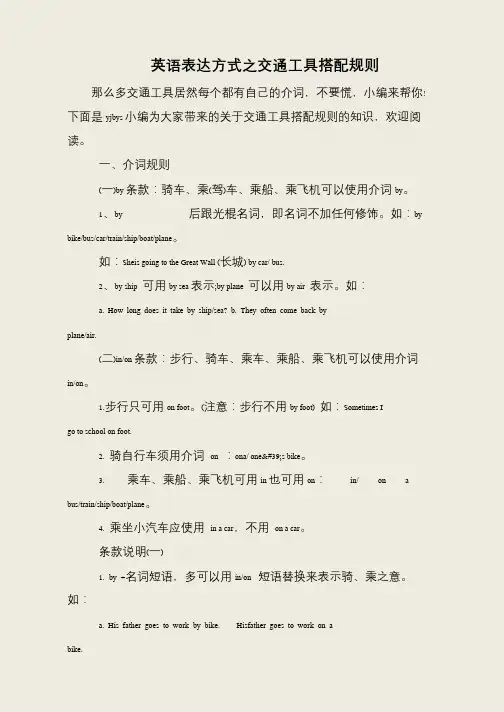
英语表达方式之交通工具搭配规则那么多交通工具居然每个都有自己的介词,不要慌,小编来帮你!下面是yjbys 小编为大家带来的关于交通工具搭配规则的知识,欢迎阅读。
一、介词规则(一)by 条款:骑车、乘(驾)车、乘船、乘飞机可以使用介词by。
1、by 后跟光棍名词,即名词不加任何修饰。
如:bybike/bus/car/train/ship/boat/plane。
如:Sheis going to the Great Wall (长城) by car/ bus.2、by ship 可用by sea 表示;by plane 可以用by air 表示。
如:a. How long does it take by ship/sea?b. They often come back by plane/air.(二)in/on 条款:步行、骑车、乘车、乘船、乘飞机可以使用介词in/on。
1.步行只可用on foot。
(注意:步行不用by foot) 如:Sometimes Igo to school on foot.2. 骑自行车须用介词on :ona/ one's bike。
3. 乘车、乘船、乘飞机可用in 也可用on:in/ on abus/train/ship/boat/plane。
4. 乘坐小汽车应使用in a car,不用on a car。
条款说明(一)1. by +名词短语,多可以用in/on 短语替换来表示骑、乘之意。
如:a. His father goes to work by bike.Hisfather goes to work on a bike.。
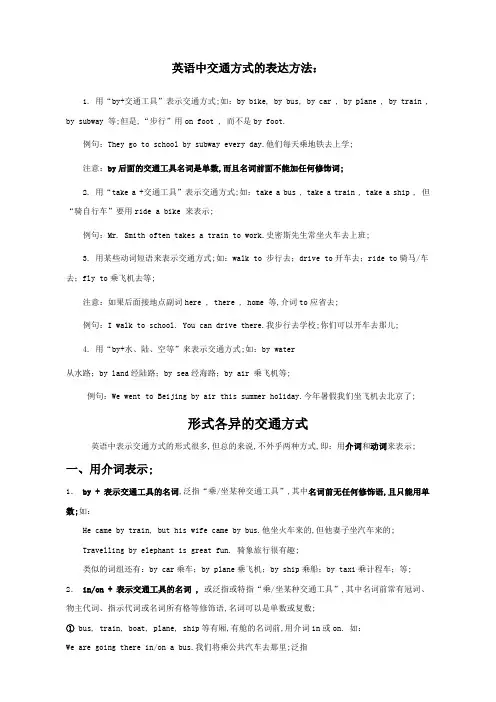
英语中交通方式的表达方法:1. 用“by+交通工具”表示交通方式;如:by bike, by bus, by car , by plane , by train , by subway 等;但是,“步行”用on foot , 而不是by foot.例句:They go to school by subway every day.他们每天乘地铁去上学;注意:by后面的交通工具名词是单数,而且名词前面不能加任何修饰词;2. 用“take a +交通工具”表示交通方式;如:take a bus , take a train , take a ship , 但“骑自行车”要用ride a bike 来表示;例句:Mr. Smith often takes a train to work.史密斯先生常坐火车去上班;3. 用某些动词短语来表示交通方式;如:walk to 步行去;drive to开车去;ride to骑马/车去;fly to乘飞机去等;注意:如果后面接地点副词here , there , home 等,介词to应省去;例句:I walk to school. You can drive there.我步行去学校;你们可以开车去那儿;4. 用“by+水、陆、空等”来表示交通方式;如:by water从水路;by land经陆路;by sea经海路;by air 乘飞机等;例句:We went to Beijing by air this summer holiday.今年暑假我们坐飞机去北京了;形式各异的交通方式英语中表示交通方式的形式很多,但总的来说,不外乎两种方式,即:用介词和动词来表示;一、用介词表示;1.by + 表示交通工具的名词,泛指“乘/坐某种交通工具”,其中名词前无任何修饰语,且只能用单数;如:He came by train, but his wife came by bus.他坐火车来的,但他妻子坐汽车来的;Travelling by elephant is great fun. 骑象旅行很有趣;类似的词组还有:by car乘车;by plane乘飞机;by ship乘船;by taxi乘计程车;等;2.in/on + 表示交通工具的名词 ,或泛指或特指“乘/坐某种交通工具”,其中名词前常有冠词、物主代词、指示代词或名词所有格等修饰语,名词可以是单数或复数;① bus, train, boat, plane, ship等有厢,有舱的名词前,用介词in或on. 如:We are going there in/on a bus.我们将乘公共汽车去那里;泛指Don't come here on /in the ship. 不要坐船来这里;特指② bike或motorbike前,只能用介词on. 如:They go to work on their bikes.他们骑自行车上班;特指She went out on her new motorbike. 她骑着她的新摩托车出去了;特指③ car,taxi前,多用介词in. 如:We are going to France in John’s car.我们将坐约翰的车去法国;特指3.by/on + 表示交通工具的名词,特指“乘/坐某一趟/辆/艘车,船等”,其中名词为单数,其前常有定冠词与数词或具体时刻一起作修饰语;如:They came here by/on the first bus.他们是坐头班车来的;You can get there by/on the Number 10 bus / bus . 你可以乘10路公共汽车到那里;He went up to London by/on the 10:30 train. 他是乘10时30分的火车去伦敦的;4.by + 表示交通工具的名词,泛指“乘/坐某种档次的交通工具旅行”,其中名词为单数,其前常有表示“等级或档次”的形容词作修饰语;如:She travels by third-class train. 她乘三等车旅行;I will go to Beijing by the fast train. 我将乘快车去北京;He flew to Paris by first class plane. 他坐头等舱飞往巴黎;He went to Tokyo by a large ship.他乘一艘大船去了东京;5.by + 表示交通线路或交通线路所经范围的名词,表示“经由陆路/水路/空中等线路旅行或运输”,其中名词为单数或不可数,其前无任何修饰语;如:Shall we go by land or by sea 我们是由陆路去还是由水路去It saves a lot of time to travel by air. 乘飞机旅行可以节省许多时间;类似的词组还有:by water由水路;by road由公路;by rail由铁路;等;6.on + 表示人或动物特定身体部位的名词,表示“步行或骑马/骆驼”,其中名词只能是foot, horseback或 camelback, 其前无任何修饰语;如:She usually goes to school on foot. 她通常步行上学;Our friends arrived on horseback.我们的朋友是骑马到的;7.on + 表示交通工具的动物名词,表示“骑驴/马/象/骆驼”,其中名词为donkey, horse, elephant 或camel, 其前常有不定冠词a/an. 如:The old man used to go out on a donkey. 那个老汉以前都是骑驴外出的;He went there on a horse. 他骑马去了那里;类似的词组还有:on an elephant骑象;on a camel骑骆驼;二、用动词表示;1.“动词 + to + 地点名词”或“动词 + 地点副词”; 这种动词主要是walk 步行,ride骑车,drive 开车,fly乘飞机,sail乘船等;如:I usually walk to school. 我通常步行上学;We sometimes ride to school. 我们有时骑车上学;They drove to the station. 他们开车去了车站;Jack flew there last Sunday. 杰克上星期乘飞机去那里了;We sailed across the Atlantic in five days.我们乘船用了五天的时间横渡大西洋; 2.“take a/the + 表示交通工具的名词”,表示“乘/坐……”;如:Will you take a bus to go there 你乘汽车去那儿吗I took a taxi to the hospital. 我坐计程车到医院去了;Tom often takes the train to go to work. 汤姆常坐这趟火车上班;类似的表达还有:take a ship乘轮船,take a plane乘飞机等;3.“ride a/an + bike,motorbike或表示交通工具的动物名词,表示“骑……”;如:I ride a bike to work every day. 我天天骑自行车上班;He came here riding a horse /an elephant. 他骑马/象来到了这里;4.“ride on/in + a/an + 表示交通工具的名词”,表示“乘/坐/骑……”;如:She gets sick when she rides in/on a bus. 她坐公共汽车时晕车;The boy liked to ride on a motorbike.那男孩喜欢骑摩托车;He often rides on an elephant to travel. 他常骑象旅行;类似的表达还有:ride in/on a ship/train/plane/boat等;辨析ride a bike着重动作;ride in/on a bike着重状态;5.“have/take a ride in/on + 表示交通工具的名词”,表示“乘/坐/骑一下/次……”;如: Would you like to have/take a ride in my new car 你要不要坐坐我的新车Can I have/take a ride on your bike 我能骑一下你的自行车吗He let me have/take a ride on his camel. 他让我骑了一下他的骆驼;6.“go for a ride in/on + 表示交通工具的名词”,表示“乘/坐/骑……去兜风”;如:They went for a ride on their horses/bicycles.他们骑马/自行车去兜了一圈;Let’s go for a ride in the car/a car ride. 我们乘汽车去兜风吧;I went for a ride on my horse before breakfast. 早餐前我骑马出去遛了遛;巩固练习:I. 用by, in, on, take填空;1.—How do you go to school every day—____ bike.2.They will go to the cinema____ bus.3.He went to the park____ a car yesterday.4.Helen will go there____ the 12:00 bus.5.Will you____ the bus to Beijing tomorrowII. 就划线部分提问;1.Mr Green goes to the post office by bike.对划线部分提问2.Ann is going shopping on foot.对划线部分提问Keys:I: 1.By 2.by 3.in 4.on /by 5.TakeII: 1. How does Mr. Green go to the post office2. How is Ann going shopping出门在外,谁也离不开交通;水、陆、空,路路通,交通可是很方便哟不过,你可要学会灵活选用交通方式,不然,就不能准时到达目的地;下面为同学们重点谈谈常见的交通表达方式:方式一用“by+交通工具名词”表示交通方式;此时交通工具的名词只能用单数,不能用复数,也不能被冠词或物主代词等修饰;如:by bike, by bus, by coach, by underground, by car, by train, by ship, by plane等;如:I came here by taxi. 我乘出租车来这儿的;We can go to the zoo by coach or underground. 我们可以乘长途汽车或地铁去动物园;Simon often goes to school by bike. 西蒙经常骑自行车去上学;方式二用“by+交通路线的位置”表示交通方式;如:by sea=by ship, by air=by plane等;如:They usually go to England by air/ plane. 他们通常乘飞机去英国;I always go to London by sea/ship. 我总是乘船去伦敦;方式三用“inon+交通工具名词”表示交通方式;此时交通工具名词前必须有冠词、名词所有格形式或形容词性物主代词等限定词修饰;如:Daniel often goes to school on a/his bike. 丹尼尔经常骑自行车去上学;Don’t come here on/in the ship. 不要坐船来这里;We go there in a car. 我们乘小汽车去那里;方式四用“take athe+交通工具名词”表示交通方式;如:take a bus, take a train, take a ship, take a plane;但“骑自行车”用ride a bike表示;“乘飞机”也可用fly to表示;“乘驾小汽车”用drive a car表示;如:Will you take a bus to go there你乘公共汽车去那儿吗Can you ride a bike to go there你能骑自行车去那儿吗We will fly to Japan next week. 下周我们将乘飞机去日本;They will drive a car to the USA. 他们将乘小汽车去美国;方式五表示“步行去某地”,可用下列两种句式:⑴go to+某地+on foot;如:She goes to work on foot. 她步行去上班;注意:on foot不可说成on feet, on a/the/my foot, by foot等;⑵walk to+某地;如:He walks to school every day. =He goes to school on foot every day. 他每天步行去上学;注意:a. walk不可与on foot连用;如上述例句不可说成:He walks to school on foot every day.b. walk to后接地点副词here, there, home时,介词to要省去;如:I usually walk home. 我通常步行回家;此外,同学们还应知道:我们在对交通方式提问时要用特殊疑问词how;如:Ann is going shopping on foot. 就划线部分提问→How is Ann going shopping。
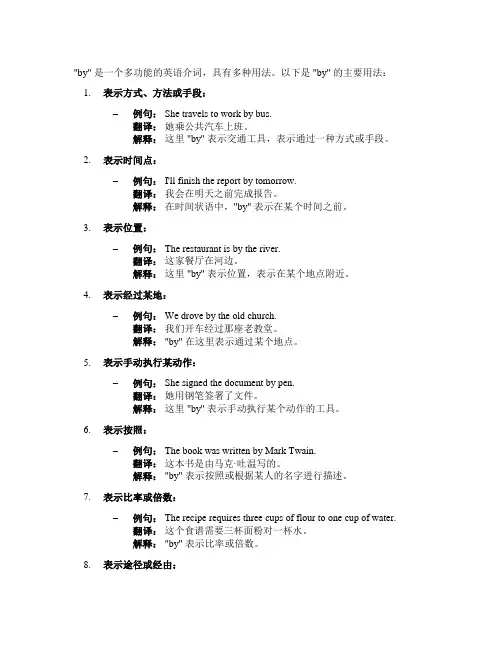
"by" 是一个多功能的英语介词,具有多种用法。
以下是 "by" 的主要用法:1.表示方式、方法或手段:–例句: She travels to work by bus.翻译:她乘公共汽车上班。
解释:这里 "by" 表示交通工具,表示通过一种方式或手段。
2.表示时间点:–例句: I'll finish the report by tomorrow.翻译:我会在明天之前完成报告。
解释:在时间状语中,"by" 表示在某个时间之前。
3.表示位置:–例句: The restaurant is by the river.翻译:这家餐厅在河边。
解释:这里 "by" 表示位置,表示在某个地点附近。
4.表示经过某地:–例句: We drove by the old church.翻译:我们开车经过那座老教堂。
解释: "by" 在这里表示通过某个地点。
5.表示手动执行某动作:–例句: She signed the document by pen.翻译:她用钢笔签署了文件。
解释:这里 "by" 表示手动执行某个动作的工具。
6.表示按照:–例句: The book was written by Mark Twain.翻译:这本书是由马克·吐温写的。
解释: "by" 表示按照或根据某人的名字进行描述。
7.表示比率或倍数:–例句: The recipe requires three cups of flour to one cup of water.翻译:这个食谱需要三杯面粉对一杯水。
解释: "by" 表示比率或倍数。
8.表示途径或经由:–例句: I came by way of the airport.翻译:我经由机场过来。
解释: "by" 表示途径或经由某地。

英语动词交通方式和介词交通方式的同义句转换英语中交通方式的表达方法:1、用“by+交通工具”表示交通方式。
如: by bike, by bus, by car , byplane , by train , by subway 等。
但是,“步行”用on foot ,而不是by foot.例句:They go to school by subway every day .他们每天乘地铁去上学。
注意: by后面的交通工具名词是单数,而且名词前面不能加任何修饰词。
2、用"take a +交通工具”表示交通方式。
如: take a bus , take a train ,take a ship,但“骑自行车”要用ride a bike来表示。
例句:Mr . Smith often takes a train to work .史密斯先生常坐火车去上班。
take+限定词(如a / the)+交通工具名词"也可表示"乘坐"。
如:You'd better take the No.3 bus to go there.l go to school by bus every day.我每天坐公共汽车上学。
She takes a bus to go to school every day.她每天坐公共汽车上学。
3、用某些动词短语来表示交通方式。
如: walk to:步行去;driveto :开车去;ride to :骑马/车去; fly to :乘飞机去等。
注意:如果后面接地点副词here , there , home等,介词to应省去。
例句:Ⅰwalk to school . You can drive there .4、用"by+水、陆、空等”来表示交通方式。
如: by water :从水路; by land :经陆路;by sea :经海路; by air:乘飞机等。
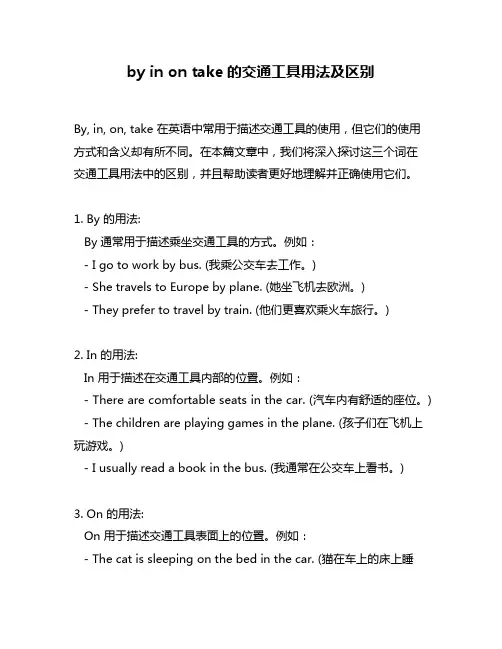
by in on take的交通工具用法及区别By, in, on, take 在英语中常用于描述交通工具的使用,但它们的使用方式和含义却有所不同。
在本篇文章中,我们将深入探讨这三个词在交通工具用法中的区别,并且帮助读者更好地理解并正确使用它们。
1. By 的用法:By 通常用于描述乘坐交通工具的方式。
例如:- I go to work by bus. (我乘公交车去工作。
)- She travels to Europe by plane. (她坐飞机去欧洲。
)- They prefer to travel by train. (他们更喜欢乘火车旅行。
)2. In 的用法:In 用于描述在交通工具内部的位置。
例如:- There are comfortable seats in the car. (汽车内有舒适的座位。
) - The children are playing games in the plane. (孩子们在飞机上玩游戏。
)- I usually read a book in the bus. (我通常在公交车上看书。
)3. On 的用法:On 用于描述交通工具表面上的位置。
例如:- The cat is sleeping on the bed in the car. (猫在车上的床上睡觉。
)- There is a blanket on her lap in the plane. (她的膝盖上有一条毯子。
)- He's standing on the platform waiting for the train. (他站在站台上等火车。
)4. Take 的用法:Take 表示搭乘或乘坐交通工具。
例如:- I take the subway to work every day. (我每天坐地铁上班。
)- She takes a taxi to the airport. (她坐出租车去机场。

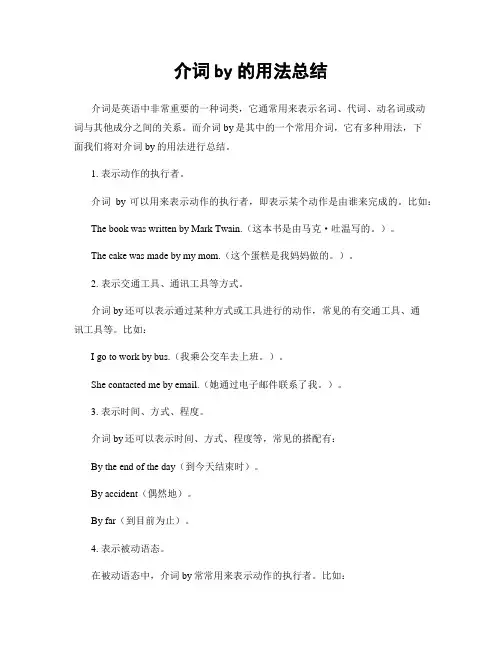
介词by的用法总结介词是英语中非常重要的一种词类,它通常用来表示名词、代词、动名词或动词与其他成分之间的关系。
而介词by是其中的一个常用介词,它有多种用法,下面我们将对介词by的用法进行总结。
1. 表示动作的执行者。
介词by可以用来表示动作的执行者,即表示某个动作是由谁来完成的。
比如:The book was written by Mark Twain.(这本书是由马克·吐温写的。
)。
The cake was made by my mom.(这个蛋糕是我妈妈做的。
)。
2. 表示交通工具、通讯工具等方式。
介词by还可以表示通过某种方式或工具进行的动作,常见的有交通工具、通讯工具等。
比如:I go to work by bus.(我乘公交车去上班。
)。
She contacted me by email.(她通过电子邮件联系了我。
)。
3. 表示时间、方式、程度。
介词by还可以表示时间、方式、程度等,常见的搭配有:By the end of the day(到今天结束时)。
By accident(偶然地)。
By far(到目前为止)。
4. 表示被动语态。
在被动语态中,介词by常常用来表示动作的执行者。
比如:The letter was delivered by the postman.(这封信是由邮递员送来的。
)。
The house was built by my grandfather.(这栋房子是我爷爷建造的。
)。
5. 表示比较。
在比较级结构中,介词by可以用来表示“比……”。
比如:The weather is getting colder by the day.(天气一天比一天冷。
)。
She is growing more beautiful by the year.(她一年比一年更漂亮。
)。
6. 表示经过。
介词by还可以表示经过某个地点或某个时间。
比如:We drove by the park on our way home.(回家的路上我们经过了公园。
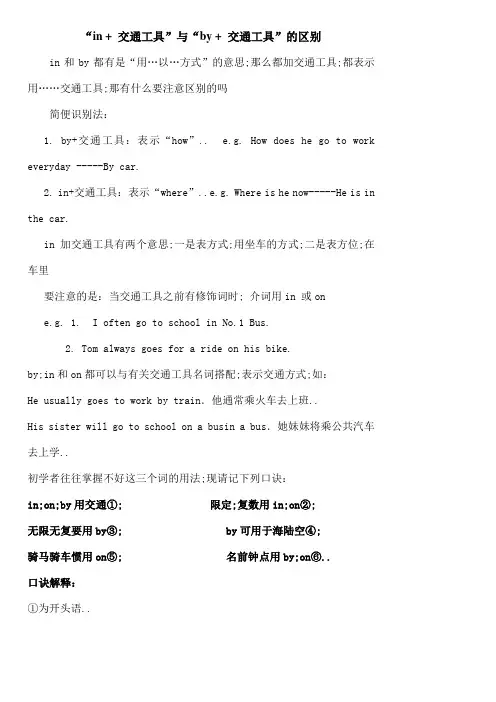
“in + 交通工具”与“by + 交通工具”的区别in和by都有是“用…以…方式”的意思;那么都加交通工具;都表示用……交通工具;那有什么要注意区别的吗简便识别法:1. by+交通工具:表示“how”.. e.g. How does he go to work everyday -----By car.2. in+交通工具:表示“where”..e.g. Where is he now-----He is in the car.in加交通工具有两个意思;一是表方式;用坐车的方式;二是表方位;在车里要注意的是:当交通工具之前有修饰词时; 介词用in 或one.g. 1. I often go to school in No.1 Bus.2. Tom always goes for a ride on his bike.by;in和on都可以与有关交通工具名词搭配;表示交通方式;如:He usually goes to work by train.他通常乘火车去上班..His sister will go to school on a busin a bus.她妹妹将乘公共汽车去上学..初学者往往掌握不好这三个词的用法;现请记下列口诀:in;on;by用交通①; 限定;复数用in;on②;无限无复要用by③; by可用于海陆空④;骑马骑车惯用on⑤; 名前钟点用by;on⑥..口诀解释:①为开头语..②当交通工具前有限定词冠词和物主代等时;介词可用“on”;也可用“in”;但不可用“by”;如:1She’ll go to Beijing onin a plane.有限定词她将乘飞机去北京.. 2Nearby were two canoes in which they had come to the island.in which=in the canoes复数附近有两只他们来这个岛乘坐的独木船..③当表示交通工具的名词前没有限定词;而且此名词又不是复数形式时;介词用“by”:Leonov got to the moon by spaceship.列昂诺夫是乘宇宙飞船登上月球的..④介词by和一些与交通有关的名词连用;表示交通方式..此时;既不能在名词前加限定词;也不能把名词改为复数形式..再者;介词by也不可以改用in或on..如:1I’m going there by sea.我乘船去..2He came to Shanghai by water.他是乘船到上海的..3They’ll go there by land.他们将从陆路去那儿..4He has returned to Beijing by air.他已乘飞机返回北京..5My brother goes to school by bike.我哥哥骑自行车去上学..⑤on horsebact骑马是固定搭配;“on”不能改为in或by..既不能在horseback前加限定词;也不能把horseback改为复数形式..如:He saw two men on horseback.他看到了两个骑马的人..另外;on与限定词加 bike连用时;不能改为in或by;如:They go to work on their bikes.他们是骑自行车上班的..⑥如果表示交通工具的名词前有具体的钟点时间修饰时;介词用“by”或“on”..如:I’ll go onbythe 9 o’clock train.我将乘九点钟的火车去。
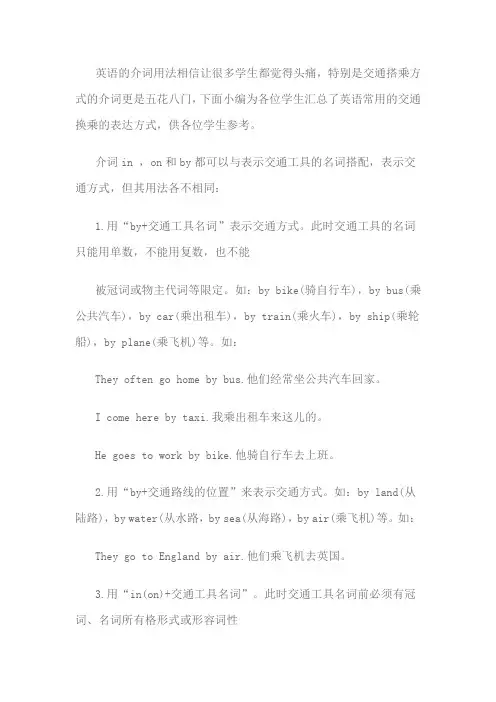
英语的介词用法相信让很多学生都觉得头痛,特别是交通搭乘方式的介词更是五花八门,下面小编为各位学生汇总了英语常用的交通换乘的表达方式,供各位学生参考。
介词in ,on和by都可以与表示交通工具的名词搭配,表示交通方式,但其用法各不相同:1.用“by+交通工具名词”表示交通方式。
此时交通工具的名词只能用单数,不能用复数,也不能被冠词或物主代词等限定。
如:by bike(骑自行车),by bus(乘公共汽车),by car(乘出租车),by train(乘火车),by ship(乘轮船),by plane(乘飞机)等。
如:They often go home by bus.他们经常坐公共汽车回家。
I come here by taxi.我乘出租车来这儿的。
He goes to work by bike.他骑自行车去上班。
2.用“by+交通路线的位置”来表示交通方式。
如:by land(从陆路),by water(从水路,by sea(从海路),by air(乘飞机)等。
如:They go to England by air.他们乘飞机去英国。
3.用“in(on)+交通工具名词”。
此时交通工具名词前必须有冠词、名词所有格形式或形容词性物主代词等限定词修饰。
其用法与“by+交通工具名词”相似。
如:He often goes to school on a(his)bike.他经常骑自行车去上学。
Don‘t come here on /in the ship.不要坐船来这里。
We go there in a car.我们乘小汽车去那里。
4.用“take a(the)+交通工具名词”表示交通方式。
如:take a bus(乘公共汽车),take atrain(乘火车),take a ship(乘轮船),take a plane(乘飞机);但“骑自行车”要用 ride abike来表示。
如:Will you take a bus to go there?你乘汽车去那儿吗?5.表示“步行去某地”,可用下列两种句式:(1)go to +某地+ on foot。
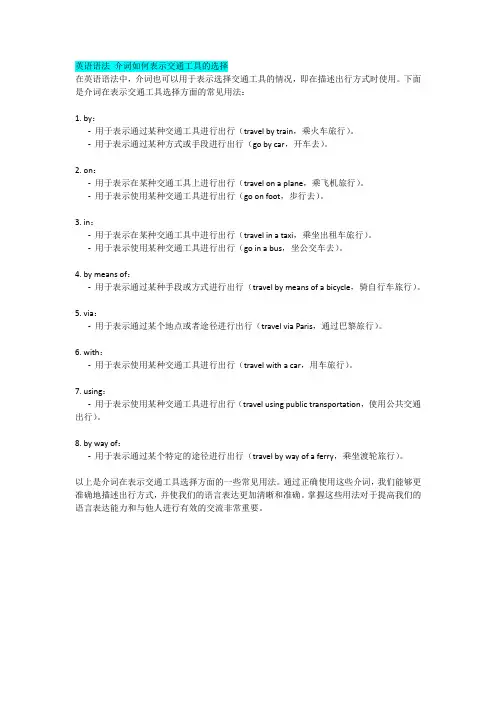
英语语法介词如何表示交通工具的选择在英语语法中,介词也可以用于表示选择交通工具的情况,即在描述出行方式时使用。
下面是介词在表示交通工具选择方面的常见用法:1. by:-用于表示通过某种交通工具进行出行(travel by train,乘火车旅行)。
-用于表示通过某种方式或手段进行出行(go by car,开车去)。
2. on:-用于表示在某种交通工具上进行出行(travel on a plane,乘飞机旅行)。
-用于表示使用某种交通工具进行出行(go on foot,步行去)。
3. in:-用于表示在某种交通工具中进行出行(travel in a taxi,乘坐出租车旅行)。
-用于表示使用某种交通工具进行出行(go in a bus,坐公交车去)。
4. by means of:-用于表示通过某种手段或方式进行出行(travel by means of a bicycle,骑自行车旅行)。
5. via:-用于表示通过某个地点或者途径进行出行(travel via Paris,通过巴黎旅行)。
6. with:-用于表示使用某种交通工具进行出行(travel with a car,用车旅行)。
7. using:-用于表示使用某种交通工具进行出行(travel using public transportation,使用公共交通出行)。
8. by way of:-用于表示通过某个特定的途径进行出行(travel by way of a ferry,乘坐渡轮旅行)。
以上是介词在表示交通工具选择方面的一些常见用法。
通过正确使用这些介词,我们能够更准确地描述出行方式,并使我们的语言表达更加清晰和准确。
掌握这些用法对于提高我们的语言表达能力和与他人进行有效的交流非常重要。
英语语法介词如何表示交通工具介词在英语语法中也被广泛用于表示交通工具,帮助我们描述乘坐或使用不同类型的交通工具。
下面是介词在表示交通工具方面的常见用法:1. by:-用于表示乘坐某种交通工具(We traveled by plane to the destination,我们乘飞机到达目的地)。
-用于表示使用某种交通工具(He commutes to work by train,他通勤乘火车上班)。
2. on:-用于表示乘坐某种交通工具(She is on the bus heading to downtown,她坐公交车去市区)。
-用于表示使用某种交通工具(He is on a bicycle,他骑自行车)。
3. in:-用于表示乘坐某种交通工具(We are in a taxi on our way to the airport,我们乘出租车去机场)。
-用于表示使用某种交通工具(He is in a car,他开车)。
4. by means of:-用于表示通过某种交通工具(They traveled by means of a private jet,他们乘坐私人飞机旅行)。
-用于表示通过某种手段或方法(They communicated by means of email,他们通过电子邮件进行沟通)。
5. via:-用于表示通过某个地点或途径(We flew to London via Paris,我们经巴黎飞往伦敦)。
-用于表示通过某种交通工具(He traveled from New York to Los Angeles via train,他乘火车从纽约到洛杉矶)。
6. with:-用于表示乘坐某种交通工具(She traveled with her friends by car,她和朋友们一起开车旅行)。
-用于表示使用某种交通工具(He goes to work with a scooter,他骑着踏板车上班)。
by做介词的常考短语介词by是英语中常用的介词之一,它有着多种不同的用法和短语,下面将为大家详细介绍。
1. 表示方式、手段或工具- by bus/train/plane:乘坐公共汽车/火车/飞机- by car/bike:开车/骑自行车- by foot:步行- by phone/email:通过电话/电子邮件2. 表示被动或代表性动作- by me/him/them:由我/他们代表- by mistake/chance:错误地/偶然地- by force/violence:强制地/暴力地3. 表示时间、期限或截止日期- by Monday/Tuesday:在周一/周二之前- by the end of the month/year:在月底/年底之前- by 5 o'clock/lunchtime:在五点钟/午餐时间之前4. 表示数量、比例或倍数关系- by two/three/four times:两倍/三倍/四倍地- by a factor of ten/twenty:以十倍/二十倍的比例5. 表示作者或创造者身份- written/painted/sculpted/designed/directed by someone:由某人编写、绘画、雕塑、设计、导演6. 表示经过或穿过某个区域或位置- pass/go by the park/museum:经过公园/博物馆- stand/sit by the window/door:站在窗户/门旁边7. 表示交通工具的位置或状态- by the roadside:在路边- by the sea/lake/river:在海边/湖边/河边- by air/sea/rail:通过空中/海上/铁路8. 其他用法- by oneself:独自一人- by heart:熟记于心- by all means:无论如何,务必总结起来,介词by有着丰富的用法和短语,包括表示方式、手段、被动、时间、数量、作者身份等等。
精心整理英语中交通方式的表达方法:1、用“by+交通工具”表示交通方式。
如:bybike,bybus,bycar,byplane,bytrain,bysubway等。
但是,“步行”用onfoot,而不是byfoot.例句:Theygotoschoolbysubwayeveryday.他们每天乘地铁去上学。
注意:by后面的交通工具名词是单数,而且名词前面不能加任何修饰词。
2、用"takea+交通工具”表示交通方式。
如:takeabus,takeatrain,takeaship,但“骑自行车”要用rideabike来表示。
例句:Mr.Smithoftentakesatraintowork.史密斯先生常坐火车去上班。
take+限定词(如a/the)+交通工具名词"也可表示"乘坐"。
如:You'dbettertaketheNo.3bustogothere.Igotoschoolbybuseveryday.我每天坐公共汽车上学。
Shetakesabustogotoschooleveryday.她每天坐公共汽车上学。
3、用某些动词短语来表示交通方式。
如:walkto:步行去;driveto:开车去;rideto:骑马/车去;flyto:乘飞机去等。
注意:如果后面接地点副词here,there,home等,介词to应省去。
例句:Iwalktoschool.Youcandrivethere.4、用"by+水、陆、空等”来表示交通方式。
如:bywater:从水路;byland:经陆路;bysea:经海路;byair:乘飞机等。
例句:Wewenttobeijingbyairthissummerholiday.5.in,on介词"in(on)+冠词(形容词性物主代词等)+交通工具名词"也可表示"乘、坐"。
in多用于带舱或车厢的交通工具名词前,侧重于封闭式的交通工具;on多用于开放式或半封闭式的交通工具。
乘坐交通工具有几种表达方式英语介词in ,on和by都可以与表示交通工具的名词搭配,表示交通方式,但其用法各不相同:1.用“by+交通工具名词”表示交通方式.此时交通工具的名词只能用单数,不能用复数,也不能被冠词或物主代词等限定.如:by bike (骑自行车),by bus(乘公共汽车),by car(乘出租车),by train (乘火车),by ship(乘轮船),by plane(乘飞机)等.如:They often go home by bus.他们经常坐公共汽车回家.I come here by taxi.我乘出租车来这儿的.He goes to work by bike.他骑自行车去上班.2.用“by+交通路线的位置”来表示交通方式.如:by land(从陆路),by water(从水路),by sea(从海路),by air(乘飞机)等.如:They go to England by air.他们乘飞机去英国.3.用“in(on)+交通工具名词”.此时交通工具名词前必须有冠词、名词所有格形式或形容词性物主代词等限定词修饰.其用法与“by+交通工具名词”相似.如:He often goes to school on a(his)bike.他经常骑自行车去上学.Don't come here on /in the ship.不要坐船来这里.We go there in a car.我们乘小汽车去那里.4.用“take a(the)+交通工具名词”表示交通方式.如:take a bus(乘公共汽车),take a train(乘火车),take a ship(乘轮船),take a plane(乘飞机);但“骑自行车”要用 ride a bike来表示.如:Will you take a bus to go there?你乘汽车去那儿吗?5.表示“步行去某地”,可用下列两种句式:(1)go to +某地+ on foot.如:She g oes to w ork on foot.她步行去上班.注意:on foot不可说成 on feet,on a /the /my foot,by foot等.(2)walk to +某地.如:He walks to school every day .=He goes to school on foot every day .他每天步行去上学.。
英语中交通方式的表达方法:1、用“by+交通工具”表示交通方式。
如:by bike, by bus, by car , by plane , by train , by subway 等。
但是,“步行”用on foot , 而不是by foot.例句:They go to school by subway every day .他们每天乘地铁去上学。
注意:by后面的交通工具名词是单数,而且名词前面不能加任何修饰词。
2、用"take a +交通工具”表示交通方式。
如:take a bus , take a train , take a ship , 但“骑自行车”要用ride a bike 来表示。
例句:Mr . Smith often takes a train to work .史密斯先生常坐火车去上班。
3、用某些动词短语来表示交通方式。
如:walk to:步行去;drive to :开车去;ride to :骑马/车去;fly to :乘飞机去等。
注意:如果后面接地点副词here , there , home 等,介词to应省去。
例句:I walk to school . You can drive there .我步行去学校。
你们可以开车去那儿。
4、用"by+水、陆、空等”来表示交通方式。
如:by water :从水路;by land :经陆路;by sea :经海路;by air:乘飞机等。
例句:We went to beijing by air this summer holiday .今年暑假我们坐飞机去北京了。
形式各异的交通方式英语中表示交通方式的形式很多,但总的来说,不外乎两种方式,即:用介词和动词来表示。
一、用介词表示。
1.by + 表示交通工具的名词,泛指“乘/坐某种交通工具”,其中名词前无任何修饰语,且只能用单数。
如:He came by train, but his wife came by bus.他坐火车来的,但他妻子坐汽车来的。
交通方式表达法✬交通方式的表达有2种,介词短语结构和动词短语结构。
1.介词短语结构(1)介词短语结构:by+交通工具名词by bike骑自行车by subway乘地铁by train乘火车on foot步行(“步行”,介词用on)(2)句型:主语+谓语+...by+交通工具名词主语乘坐某种交通工具去做某事或去某地He goes to travel by plane.他乘飞机去旅行。
She came here by subway.她乘地铁来这儿。
Robinson goes to the island(岛屿)by boat.鲁滨逊乘小船上岛。
解析:①介词短语结构,用“介词by+交通工具名词”。
这种结构只作方式状语,位于句末;不能作谓语,必须给句子补充合适的谓语动词,如go,come to…等。
②by后的交通工具名词,只用可数单数名词或不可数名词;且名词前不能加a,the 等任何修饰词。
如:by a bike×by my bike2.动词短语结构(1)动词短语结构:take+a/the+交通工具名词take a bus乘公共汽车take the subway乘地铁(美式)ride a bike骑自行车walk步行to do sth(2)句型:主语+take a/the+交通工具+to+地点表示主语乘坐某种交通工具去做某事或去某地We take a bus to have the physical test(体能测试).She takes a car to the supermarket(超市).My sister sometimes walks home.(home是副词,副词前须去to)She rides a bike to the park on weekends.We took a ship to Meizhou island last Sunday.解析:动词短语结构,用“take+冠词+交通工具名词(单数)”。
英语中交通方式的表达方法:1、用“by+交通工具”表示交通方式。
如:by bike, by bus, by car , by plane , by train , by subway 等。
但就是,“步行”用on foot , 而不就是by foot、例句:They go to school by subway every day 、她们每天乘地铁去上学。
注意:by后面的交通工具名词就是单数,而且名词前面不能加任何修饰词。
2、用"take a +交通工具”表示交通方式。
如:take a bus , take a train , take a ship , 但“骑自行车”要用ride a bike 来表示。
例句:Mr 、Smith often takes a train to work 、史密斯先生常坐火车去上班。
3、用某些动词短语来表示交通方式。
如:walk to:步行去;drive to :开车去;ride to :骑马/车去;fly to :乘飞机去等。
注意:如果后面接地点副词here , there , home 等,介词to应省去。
例句:I walk to school 、You can drive there 、我步行去学校。
您们可以开车去那儿。
4、用"by+水、陆、空等”来表示交通方式。
如:by water :从水路;by land :经陆路;by sea :经海路;by air:乘飞机等。
例句:We went to beijing by air this summer holiday 、今年暑假我们坐飞机去北京了。
形式各异的交通方式英语中表示交通方式的形式很多,但总的来说,不外乎两种方式,即:用介词与动词来表示。
一、用介词表示。
1. by + 表示交通工具的名词,泛指“乘/坐某种交通工具”,其中名词前无任何修饰语,且只能用单数。
如:He came by train, but his wife came by bus、她坐火车来的,但她妻子坐汽车来的。
Travelling by elephant is great fun、骑象旅行很有趣。
类似的词组还有:by car乘车;by plane乘飞机;by ship乘船;by taxi乘计程车;等。
2. in/on + 表示交通工具的名词,或泛指或特指“乘/坐某种交通工具”,其中名词前常有冠词、物主代词、指示代词或名词所有格等修饰语,名词可以就是单数或复数。
①bus,train,boat,plane,ship等有厢,有舱的名词前,用介词in或on。
如:We are going there in/on a bus、我们将乘公共汽车去那里。
(泛指)Don't come here on /in the ship.不要坐船来这里。
(特指)②bike或motorbike前,只能用介词on。
如:They go to work on their bikes、她们骑自行车上班。
(特指)She went out on her new motorbike、她骑着她的新摩托车出去了。
(特指)③car,taxi前,多用介词in。
如:We are going to France in John’s car、我们将坐约翰的车去法国。
(特指)3. by/on + 表示交通工具的名词,特指“乘/坐某一趟/辆/艘(车,船等)”,其中名词为单数,其前常有定冠词与数词或具体时刻一起作修饰语。
如:They came here by/on the first bus、她们就是坐头班车来的。
You can get there by/on the Number 10 bus / bus No、10、您可以乘10路公共汽车到那里。
He went up to London by/on the 10:30 (train)、她就是乘10时30分的火车去伦敦的。
4. by + 表示交通工具的名词,泛指“乘/坐某种档次的交通工具旅行”,其中名词为单数,其前常有表示“等级或档次”的形容词作修饰语。
如:She travels by third-class train、她乘三等车旅行。
I will go to Beijing by the fast train、我将乘快车去北京。
He flew to Paris by first class (plane)、她坐头等舱飞往巴黎。
He went to Tokyo by a large ship、她乘一艘大船去了东京。
5. by + 表示交通线路或交通线路所经范围的名词,表示“经由陆路/水路/空中等线路旅行或运输”,其中名词为单数或不可数,其前无任何修饰语。
如:Shall we go by land or by sea ? 我们就是由陆路去还就是由水路去?It saves a lot of time to travel by air、乘飞机旅行可以节省许多时间。
类似的词组还有:by water由水路;by road由公路;by rail由铁路;等。
6. on + 表示人或动物特定身体部位的名词,表示“步行或骑马/骆驼”,其中名词只能就是foot、horseback或camelback,其前无任何修饰语。
如:She usually goes to school on foot、她通常步行上学。
Our friends arrived on horseback、我们的朋友就是骑马到的。
7. on + 表示交通工具的动物名词,表示“骑驴/马/象/骆驼”,其中名词为donkey、horse、elephant或camel,其前常有不定冠词a/an。
如:The old man used to go out on a donkey、那个老汉以前都就是骑驴外出的。
He went there on a horse、她骑马去了那里。
类似的词组还有:on an elephant骑象;on a camel骑骆驼。
二、用动词表示。
1. “动词+ to + 地点名词”或“动词+ 地点副词”。
这种动词主要就是walk (步行),ride(骑车),drive(开车),fly(乘飞机),sail(乘船)等。
如:I usually walk to school、我通常步行上学。
We sometimes ride to school、我们有时骑车上学。
They drove to the station、她们开车去了车站。
Jack flew there last Sunday、杰克上星期乘飞机去那里了。
We sailed across the Atlantic in five days、我们乘船用了五天的时间横渡大西洋。
2. “take a/the + 表示交通工具的名词”,表示“乘/坐……”。
如:Will you take a bus to go there?您乘汽车去那儿不?I took a taxi to the hospital、我坐计程车到医院去了。
Tom often takes the train to go to work、汤姆常坐这趟火车上班。
类似的表达还有:take a ship(乘轮船),take a plane(乘飞机)等。
3. “ride a/an + bike,motorbike或表示交通工具的动物名词,表示“骑……”。
如:I ride a bike to work every day、我天天骑自行车上班。
He came here riding a horse /an elephant、她骑马/象来到了这里。
4. “ride on/in + a/an + 表示交通工具的名词”,表示“乘/坐/骑……”。
如:She gets sick when she rides in/on a bus、她坐公共汽车时晕车。
The boy liked to ride on a motorbike、那男孩喜欢骑摩托车。
He often rides on an elephant to travel、她常骑象旅行。
类似的表达还有:ride in/on a ship/train/plane/boat等。
【辨析】ride a bike着重动作;ride in/on a bike着重状态。
5. “have/take a ride in/on + 表示交通工具的名词”,表示“乘/坐/骑一下/次……”。
如: Would you like to have/take a ride in my new car ? 您要不要坐坐我的新车?Can I have/take a ride on your bike ? 我能骑一下您的自行车不?He let me have/take a ride on his camel、她让我骑了一下她的骆驼。
6. “go for a ride in/on + 表示交通工具的名词”,表示“乘/坐/骑……去兜风”。
如:They went for a ride on their horses/bicycles、她们骑马/自行车去兜了一圈。
Let’s go for a ride in the car/a car ride、我们乘汽车去兜风吧。
I went for a ride on my horse before breakfast、早餐前我骑马出去遛了遛。
巩固练习:I:用by,in,on,take填空。
1.—How do you go to school every day?—____ bike.2.They will go to the cinema ____ bus.3.He went to the park ____ a car yesterday.4.Helen will go there ____ the 12:00 bus.5.Will you ____ the bus to Beijing tomorrow?II:就划线部分提问。
1.Mr Green goes to the post office by bike.(对划线部分提问)2.Ann is going shopping on foot.(对划线部分提问)Keys:I: 1.By 2.by 3.in 4.on /by 5.TakeII: 1、How does Mr Green go to the post office?2、How is Ann going shopping ?出门在外,谁也离不开交通。
水、陆、空,路路通,交通可就是很方便哟!不过,您可要学会灵活选用交通方式,不然,就不能准时到达目的地。
下面为同学们重点谈谈常见的交通表达方式:[方式一] 用“by+交通工具名词”表示交通方式。